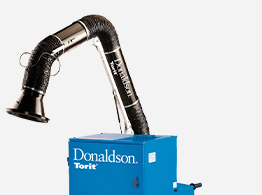By Karen Wear, Donaldson Torit Product Manager
Are you considering the installation of ambient weld fume collection in your facility? Ambient systems provide some benefits ducted systems don’t, so they’re worth a review, but following are some common misconceptions to consider before you make a final decision:
Misconception 1: Airflow patterns can easily be predicted.
Reality: The truth is we can’t be certain air will flow in a direction just because we want it to. Airflow patterns can certainly be predicted by sophisticated modeling software, but air can only be forced in a direction when it is channeled in a container (such as a duct). Airflow modeling software has its limitations, as air patterns are affected by fans, make-up air systems, open windows and doors, large stationary machines, moving machines, beams/poles, curtains, and even the people moving in the plant. Computer models give us a general idea of air patterns, but measuring patterns in the real world is the only way to see how the air actually flows.
Misconception 2: Air can be forced in a push/pull pattern.
Reality: Systems designed to create a circular or race track air pattern are often not as effective as shown on paper. Depending on the size of facility and the disturbing influences, air may simply not have enough energy to push across a large expanse and complete the designed circuit. Air exhaust can be thrown long distances, but it is practically impossible to pull air across even a very short distance. Air exiting a duct retains roughly 10% of the exhaust velocity thirty diameters from the duct, but air entering a duct is moving at 10% of the inlet velocity only when it gets within about one diameter of the duct. To overcome this condition of physics, a larger volume of air has to be forced to move in order to create the capture of fume at the intake of a system. Therefore it takes a much larger fan (at a much high energy cost) to produce this type of airflow pattern for large volume spaces, and there may still be a gap where the pushed air just can’t reach the next collector in the circuit.
Misconception 3: Ambient collection can be focused on one area.
Reality: Ambient control strategies function by allowing contaminants to be diluted as they enter the plant air space. The plant air is then filtered to avoid an increase in contaminant concentrations above an acceptable threshold. Contaminants are diluted by the general air in the plant not just the air from the welding operations or specific areas of the facility, unless physical barriers are used to isolate the contaminant-producing sections of the plant.
Directional nozzles can help direct air in a certain direction, but the air will diffuse into the overall room as it leaves the exhaust opening. The reality is that the only way to prevent fume from dispersing into the general surrounding plant environment is to collect it at the source and prevent the contaminant from being diluted by plant air.
Misconception 4: Ambient systems have a smaller footprint than multiple source collection systems.
Reality: In general, ambient collectors need to be larger than source collectors because they filter the entire volume of air in the plant several times an hour. Ambient collection is generally considered as dilution ventilation to control average concentrations of contaminants in the plant at or below the acceptable threshold for the contaminant.
Efficient filters can remove the contaminants, but ambient collection removes the contaminant only after those contaminants have passed through the breathing zone of the worker. By comparison, source capture strategies use smaller air volumes to control contaminants at their points of generation so contaminants are directed to collectors before they reach the breathing zone of workers. The net result is often a smaller total footprint for source control of contaminants.
Misconception 5: Inlet location does not matter.
Reality: There are no formal industrial ventilation guidelines for ambient fume collection, but here is a general observation. Weld fume tends to rise, due to heat during generation, until it reaches the elevation of any stagnant air layer in the plant. This fume creates a blanket of fume that lingers and concentrates. The actual elevation of this stagnant layer is influenced by many variables including the shape and temperature of the plant ceiling and the presence and influence of all the disturbing air currents in the plant. Collection strategies that employ high air inlets and floor-level filtered air returns tend to leverage the fume’s natural rise and can disrupt the stagnant layer effect, creating a general air pattern that carries fume to the filtration systems inlets.
By contrast, when air inlets are too low (below the stagnant air layer elevation), or filtered air is returned too high (above the stagnant air layer elevation), air patterns created in the plant can actually work against controlling the fume, leading to poor overall system performance.
Misconception 6: Ambient collection protects plant workers.
Reality: Ambient collection strategies seem like a great way to ensure concentrations of fume are kept low to avoid over-exposure, but ambient fume collection is a dilution ventilation strategy. In ambient collection strategies, contaminants pass through the workers breathing zone as they are being diluted by plant air. The collector system works to remove contaminants at a rate to avoid increasing contaminant concentrations on average in the plant, but fumes pass through the workers breathing zone before they are fully diluted, creating an opportunity for over-exposure. To avoid this risk, you may need other strategies, such as Personal Protection Equipment (PPE). Source collection strategies avoid the over-exposure risk by controlling the contaminants at their point of generation thereby preventing contaminants from crossing the breathing zone of the worker.
Summary
Ambient collection strategies can provide some benefits, but you must understand their limitations and implement them only when they fit your plant’s needs. To ensure you address worker over-exposure and facility housekeeping, consider a combination of source and ambient collection, and PPE to cover your entire weld fume collection needs.




